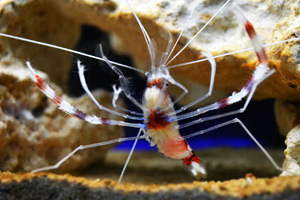Among the various ornamental crustaceans available in the marine aquarium trade, one of the most popular and easiest to obtain is Stenopus hispidus, the banded coral shrimp, also known by the common names coral banded shrimp, banded boxer shrimp, barber pole shrimp, and others. This shrimp’s widespread availability and usually very affordable price tag can be attributed to its extensive natural distribution, which includes all tropical seas.
Physical traits
S. hispidus is white with distinct red bands on its body and third pair of legs, and it sports long, flowing, white antennae. The third pair of legs is also significantly oversized compared to the others (hence the “boxer” appellation) and equipped with somewhat formidable pincers. Maximum length for the species is around 4 inches (not counting the antennae), though most specimens won’t reach that appreciable size in the aquarium.
Feeding
The banded coral shrimp is not a finicky feeder in the least and will readily accept any suitably sized meaty foods as well as dry flakes and pellets. This species is also a facultative cleaner of fish, though the specimens I’ve kept have been fairly lackluster in this regard. Results will vary from one individual to the next, but in my opinion/experience, certain Lysmata spp. shrimps (e.g., L. amboinensis and L. debelius) are much more reliable cleaners.
Housing
S. hispidus needs lots of rocky overhangs, caves, and crevices in which to refuge, and it is often found clinging to the undersides of rocks in an upside-down posture. With respect to aquarium size, it doesn’t need a particularly large tank, but I would make one argument in favor of at least a medium-sized system (say, in the vicinity of around 30 gallons or more): This shrimp is very sensitive to changes in water chemistry and will, therefore, benefit from the stability that greater water volumes provide. It’s also critical to acclimate these shrimps to new aquarium conditions very slowly.
Compatibility
Two of these shrimps can be kept together only if you can be certain of acquiring a mated pair. Otherwise, keep them one to a tank. Also, S. hispidus can be a threat to other small crustaceans (e.g, hermits and other cleaners) and even small fishes, so choose its tankmates carefully.
On the other hand, the banded coral shrimp is vulnerable to being eaten by crustacean-crunching fishes, such as triggers, lionfishes, and groupers, so when it comes to fishy tankmates, you have to split the difference between those small enough to be snatched by the shrimp and those big enough to swallow the shrimp (or those that have the dentition to reduce a shrimp to bite-size pieces).
With respect to reef-friendliness, S. hispidus is somewhat hit or miss. I’ve heard/read accounts of peaceful coexistence between banded coral shrimps and sessile invertebrates, but there are also reports of these shrimps attacking fleshier corals and anemones. The best advice I can give in this regard is to be wary of introducing one of these shrimps to a reef system, watch the specimen carefully if you do, and be ready to remove it at the first sign of trouble.





